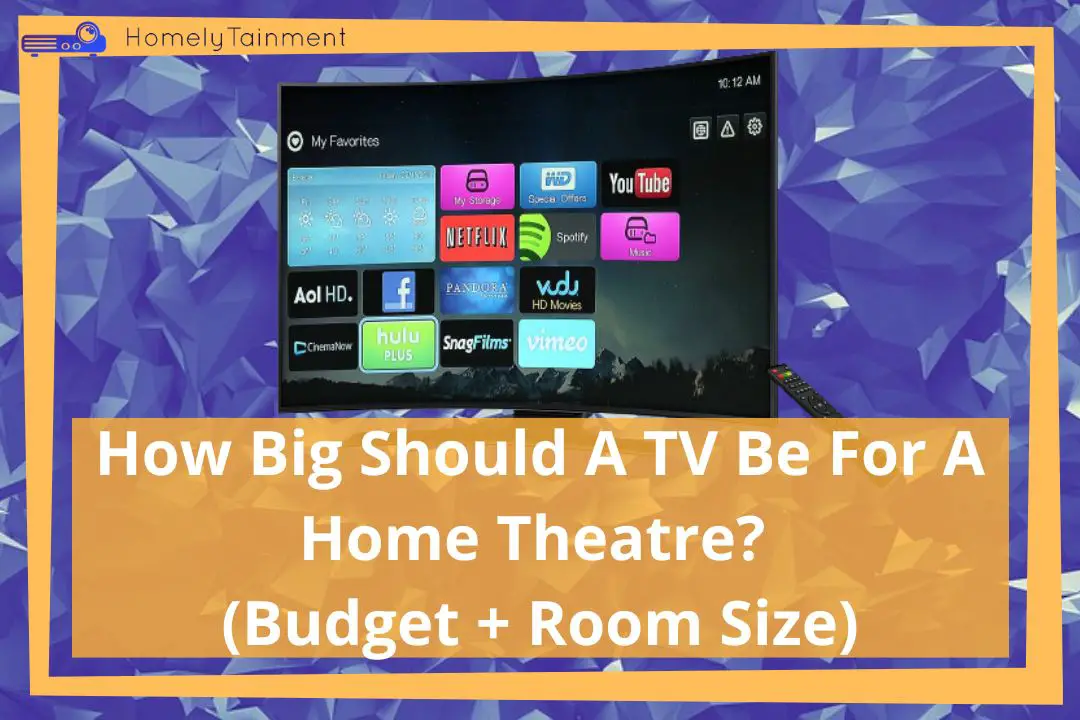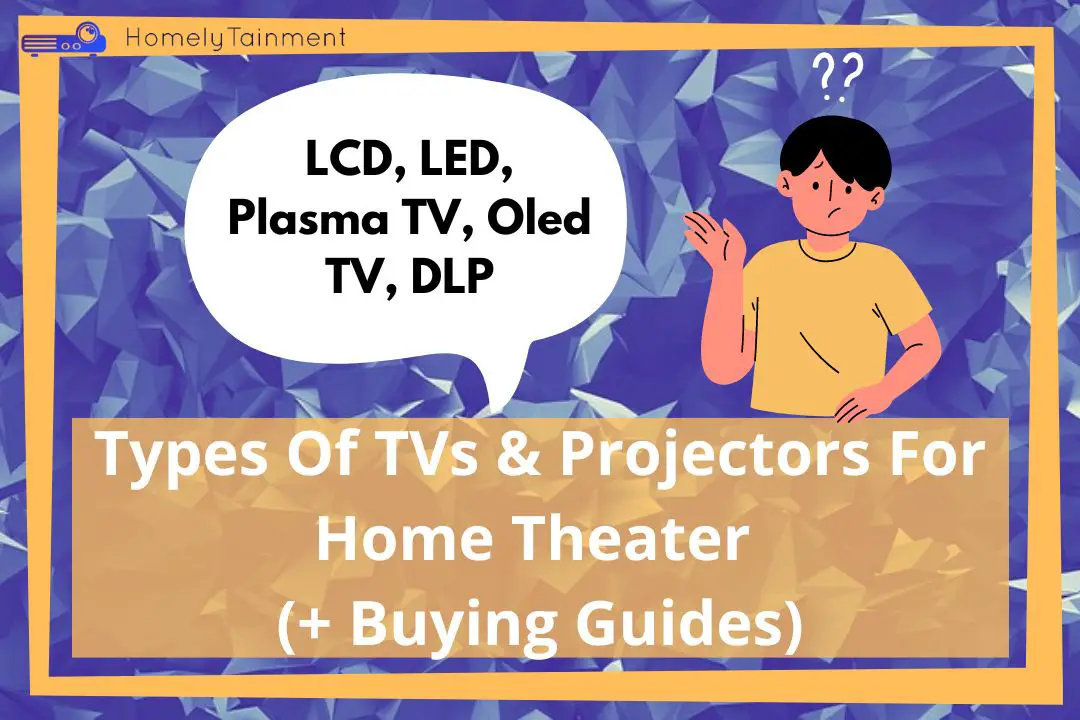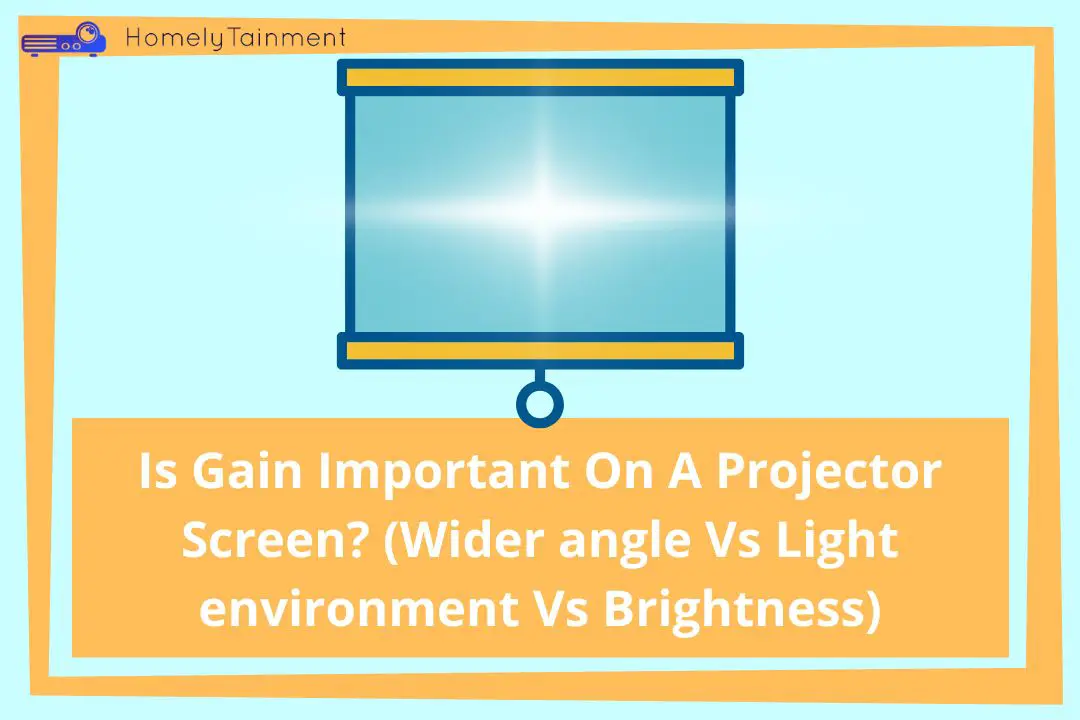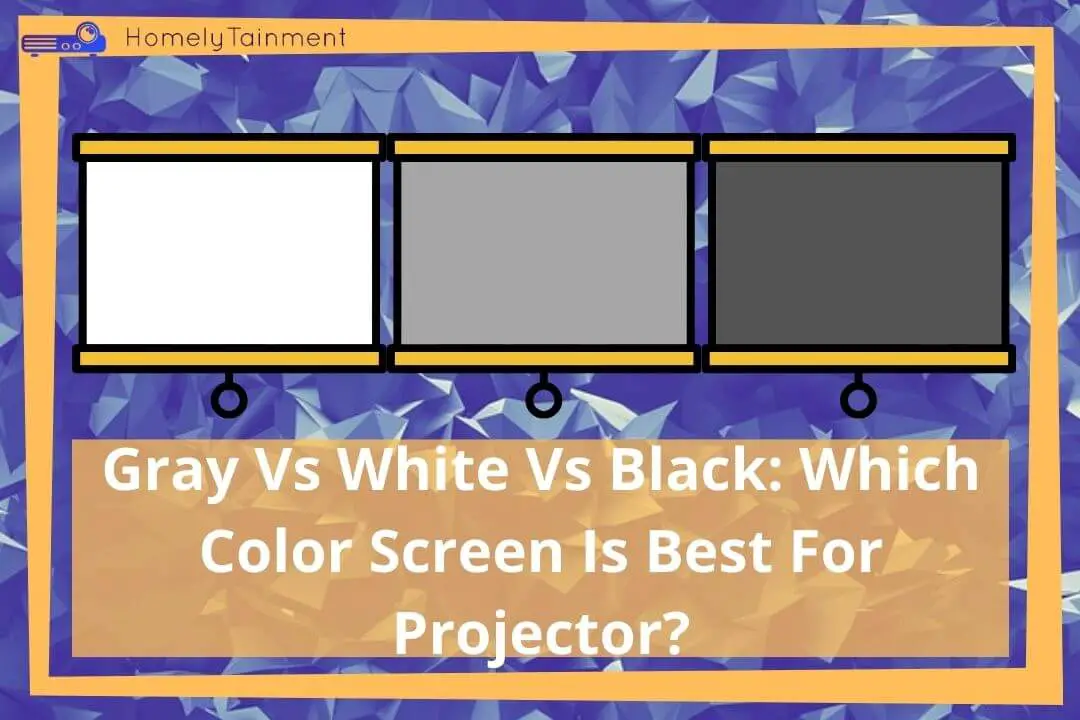
Homelytainment earn commissions (at no additional cost to you) if you purchase products from retailers after clicking on a link from our site.
There are three most common colors to be found in projector screens. These colors will confuse many to choose what for their home theater. I have written this guide to make it easier for you guys. So, Which color screen is best for a projector?
At A Glance: If the projector has less lumens and the room is painted black with no ambient light then you can go for a white screen but if the projector has higher lumens and little ambient light then you can go for gray if there is ambient light and no black paint then go for a black screen.
Keep reading as we will be comparing these three colors in detail and will compare them in many features. I will also answer related questions about these color differences.
Grey Vs White Vs Black. Comparison.
| Feature | White Screen | Grey Screen | Black Screen |
|---|---|---|---|
| Picture Quality | 6/10 | 8/10 | 10/10 |
| Contrast Ratio | 7/10 | 9/10 | 10/10 |
| Colors Vibrancy | 10/10 | 9.5/10 | 9/10 |
| Colors during Ambient Light presence | 3/10 | 6/10 | 10/10 |
| Wider Viewing Angle | 10/10 | 5/10 | 3/10 |
| HDR Content Friendliness | 7/10 | 8.5/10 | 10/10 |
Picture quality
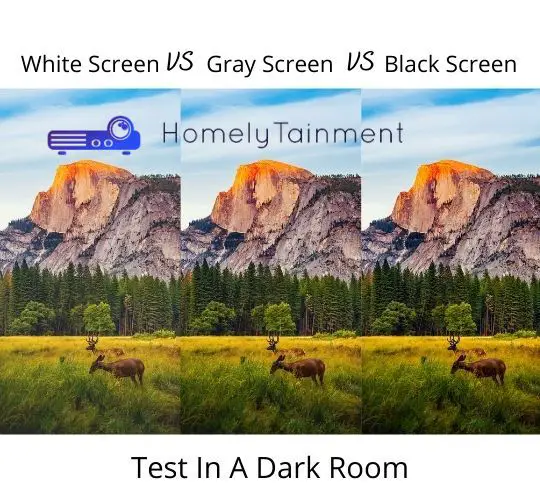
The detail in picture quality is the key to the best theater experience. You need to see the colors or the presence of very small things on the screen.
When the detailing of the things on the screen is equally spread from the edges to the middle of the screen. After that, it can immerse you in the situation of the content. When you are watching movies or playing games, you want to feel the situation of that. This is the reason why bigger screens were developed.
When it comes to picture quality. The black screens provide the most detail in the picture, followed by gray and then white respectively.
Here the black screen is the winner.
Read these 13 tips to improve the video and audio of your home theater. I have added the best ones.
Contrast Ratio
The contrast ratio is the most important, but there is a reason that I am discussing it as the second number.
The contrast ratio defines the difference between the black and white areas of the screen. The deeper the black levels or higher the contrast ratio, the better the picture quality is.
The reason I am discussing it second is that it is the backbone of the detailing in the picture. Due to the contrast ratio, the detail in the picture is alive.
It is very important to have a clear boundary between black and whites. Just look up to the sky in the city, and they look to the sky in the countryside of your country. The stars will shine better, and the blacks will look good in the countryside.
I am loving the sky more in Honesdale than in Philly (Philadelphia).
The contrast ratio is the best on the black screen.
Choose the best contrast ratio projector. Read the review of the best short throw projectors. I have reviewed the top 5 here.
Why is the contrast ratio the best on the black screen?
The projector doesn’t create black color. When it is about to show the blacks on the screen, it simply shut downs the pixel light on those areas of the screen.
That’s why the projector needs the help of the screen to create deeper blacks. When the light is shut down on a few areas of the screen, then these black screens color will help the projector produce deep blacks.
That’s why the contrast ratio is good, and the blacks are deeper on the black screen.
Color Vibrancy
The color vibrancy can be spotted best on the white screen than on the others. Because to show color vibrancy you need brighter colors.
The brightness can be boosted best on a white screen. The colors on the white screen look so vibrant across the screen.
If you love to watch animated movies and want their colors to be vibrant then the white screen is the best for you. But don’t jump to a conclusion so early. Read the final verdict to know exactly what you need & want.
Know which type of projector is best for home theater. The DLP, 3chip DLP, 3LCD, or LCoS projector. I have compared them all.
Colors during Ambient Light presence
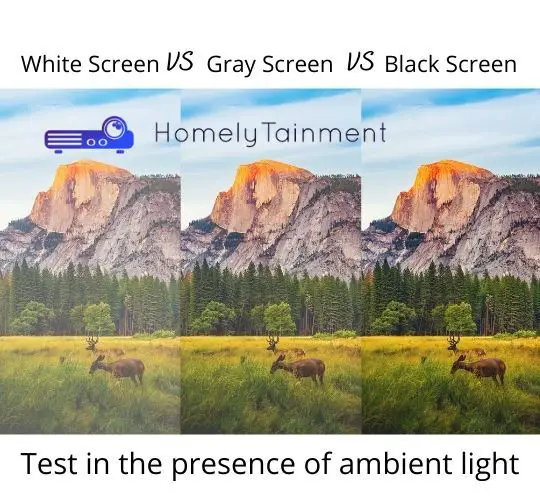
The black screen is the best fighter against the ambient light. When there is no ambient light the three will perform better but still, you will see the contrast ratio difference among them all. But when the light is turned on, the colors on the white screen wash out.
The gray still maintains the contrast ratio and the black have the best colors and picture quality in the presence of ambient light.
While in the dark the contrast ratio will be slightly better on the black screen, but in the presence of ambient light, the black screen can blow the white screen out of water.
In the ambient light fighting, the black is the winner.
Wider Viewing Angle
The white has a wider viewing angle. The picture will look good even when you are viewing it from the corner of the room.
While watching the black and gray screen from the corner. The whole picture will be so dark and there will be no vibrancy in the colors on the screen.
This is because the darker color screens absorb the light and the whites reflect it a lot. You can see the image reflection from wider angles too.
Know which is the best screen size and aspect ratio for home theater. I have written this guide to have the best experience.
How to get a wider viewing angle on a gray or black screen?
If you want a wider viewing angle on the Black and gray screen, then you can go for the ALR screen. This type of screen provides the best colors in the presence and no presence of ambient light and also provides a wider viewing angle than a normal white screen.
You can read more about it here, Is an ALR screen worth it? I have compared it both in price and picture quality with normal screens.
I will talk about the screens in the final verdict by keeping the ALR screen on the side.
HDR Content Friendliness
If you are a fan of HD content like me, then you will love the black screens. The black screen provides the best HDR content experience possible.
The black screen provides the needed black levels that can satisfy HDR content delivery.
For HDR content, you need superior blacks. So, the HDR content can provide the needed difference among the colors and among the bright and black levels of the image.
That’s why the black screen works the best for HDR content.
Final Verdict
- If your home theater will have more than two people, then go for a white screen because you will have a wider viewing angle and the image will look great from all the seating positions.
- But if you are a videophile who needs perfect video, then go for a black screen no matter what your theater room conditions.
- If you watch animated movies and love the color vibrancy, then go for a white color screen.
- If your projector has higher lumens and the room has ambient light then go for the black screen, but if the room’s walls and the ceiling have pitch-black paint and your projector has fewer lumens then go for a white screen.
There are four points in the final verdict, but they are for four different situations. You can read and then choose that one final verdict point that suits your needs. You can mix two points to pick the best for you.
Recommendations
I will recommend this screen below. It has a 2-year warranty and a 4K/8K capable screen.
What if you color the wall instead of using a screen?
Coloring the wall with the best paint color will not save your show. There is a natural difference between the wall and the fabric of the projector screen.
The wall can’t be painted smooth. There will be a lot of roughness on the surface that will mess with the pixels of the image.
Also, the paints reflect the light irregularly. You will see the reflection of the projector bulb a lot on the wall rather than the screen.
This is why it is not enough to paint the wall black. The magic is not in black, but also in the nature of the screen too.
FAQs
Will a projector work on a colored wall?
The color of the wall other than black, gray, and white will look worse. It is not recommended by me to project on a white wall too, but other colors are not worth it at all.
The color of the wall will mess with the color vibrancy of the projected image. I have used a projector both on white and pink walls. My room has a pink wall. Yes, I have. Men like this color too.
There was a pinkish touch to the whole image of the projector on a pink wall. This is why it is not recommended to project images on a colored screen.
However, if you want to project the image on the wall for some reason then you can go with white, gray, or black color. They will look okay.
Does the screen matter with a projector?
The screen does matter. There are ALR screens that drastically improve the overall image quality. You don’t need just a great projector, but a great screen too.
The screen color and nature both are necessary for the best image experience. You project the same image on the wall, fabric, and the ALR screen of the same color. The image colors and quality will differ from one another.
What is the best surface to project onto?
The best is the fabric with ALR properties. The ALR screen is the best to project images on it.
Just the nature of the surface won’t help you if you want perfection in the picture quality of the projector. You need an ALR screen that will reflect and reject light in a way that will refine the image for you and will allow only a pure form of the image without impurities.
Helpful Resources For The FAQs To Read More
- This was my opinion, read more about it from Epson Blog. (Resource for the first answer)
- This was my opinion, read more about it from this Reddit discussion. (Resource for the second answer)

